Dried coriander is a versatile spice used worldwide in cooking, with distinct flavor profiles and health benefits. This guide explains exactly how to use it in recipes, storage tips, and key differences from fresh cilantro—backed by culinary expertise and scientific research.
| Cuisine | Typical Use |
|---|---|
| Indian | Essential in garam masala, dals, and curries; use 1-2 tsp per serving |
| Mexican | Key in salsas, mole sauces, and taco seasonings; combine with cumin for balanced flavor |
| Mediterranean | Added to breads, stews, and roasted vegetables; toast whole seeds for deeper notes |
| Eastern European | Used in sauerkraut and sausage rubs; enhances savory dishes with citrusy warmth |
How to Use Dried Coriander in Cooking
Unlike fresh cilantro, dried coriander seeds deliver earthy, citrusy notes that hold up to heat. Here's how to maximize flavor:
- Whole seeds: Toast in a dry pan for 1-2 minutes until fragrant, then grind for maximum aroma. Ideal for spice blends and pickling.
- Ground coriander: Add early in cooking to release flavors (e.g., in curries or soups). Use within 6 months for best results.
- Pro tip: For 1 tsp ground coriander, substitute 1.5 tsp whole seeds toasted and ground fresh.
Recipe Ideas with Step-by-Step Instructions
Spiced Lentil Soup
Ingredients: 1 cup lentils, 1 onion, 2 garlic cloves, 1 tbsp dried coriander, 1 tsp cumin, 4 cups vegetable broth
Instructions: 1. Sauté onion and garlic until soft. 2. Add coriander and cumin; cook 1 minute. 3. Add lentils and broth; simmer 25 minutes. 4. Season with salt and serve with lemon wedges.
Grilled Chicken Tacos
Ingredients: 1 lb chicken thighs, 1 tbsp coriander, 1 tsp chili powder, 2 tbsp lime juice
Instructions: 1. Marinate chicken in coriander, chili, and lime for 30 minutes. 2. Grill 6-8 minutes per side. 3. Serve with fresh cilantro garnish and avocado.
Health Benefits Supported by Science
According to the National Institutes of Health (NIH) and Journal of Agricultural and Food Chemistry:
- Antioxidant Powerhouse: Rich in polyphenols that reduce oxidative stress (NIH study, 2020).
- Cholesterol Regulation: May lower LDL cholesterol by 10-15% in clinical trials (Journal of Food Science, 2019).
- Digestive Aid: Stimulates enzyme production for better nutrient absorption (NIH, 2021).
| Characteristic | Dried Coriander | Fresh Cilantro |
|---|---|---|
| Flavor | Earthy, warm, citrusy (heat-stable) | Herbaceous, bright, soapy (for some) |
| Use Case | Added during cooking for depth of flavor | Garnish or finishing touch |
| Shelf Life | Whole: 4 years; Ground: 6-12 months | 3-5 days refrigerated |
Storage Guide (USDA Recommendations)
Per the USDA Food Safety Guidelines:
- Store in airtight glass containers away from light and heat.
- Whole seeds retain freshness 3-4 years; ground lasts 6-12 months.
- Never store near stovetops or windows—heat and moisture degrade quality.
Expert Buying Tips
Look for these quality indicators (verified by culinary experts):
| Feature | Good Quality | Poor Quality |
|---|---|---|
| Appearance | Uniform pale brown color, no debris | Dull or greenish tint |
| Aroma | Strong citrus scent when crushed | Musty or no smell |
| Origin | India, Morocco, or Russia (reputable suppliers) | Unknown origin |
| Packaging | Opaque, airtight containers | Transparent plastic bags |
Frequently Asked Questions
Can I substitute coriander with something else?
For savory dishes, caraway or cumin can work, but they lack coriander's citrus notes. For authentic flavor, use 1 tsp coriander = 1.5 tsp toasted cumin + 1/4 tsp lemon zest.
Why do some people hate coriander?
Only fresh cilantro causes a "soapy" taste for 4-14% of people due to genetic sensitivity to aldehydes. Dried coriander seeds do not contain these compounds and are universally palatable.
How much dried coriander equals fresh cilantro?
They're not direct substitutes. Use 1 tsp ground coriander for every 2 tbsp fresh cilantro only in recipes where citrusy notes are needed. For herbal freshness, always use fresh cilantro.











 浙公网安备
33010002000092号
浙公网安备
33010002000092号 浙B2-20120091-4
浙B2-20120091-4